Creature Feature
Florida Keys National Marine Sanctuary offers a range of habitats and a home for more than 6,000 different animals. Here's a look at some of the more prominent flora and fauna you may encounter while exploring the sanctuary. This list is not comprehensive.
The wildlife in Florida Keys National Marine Sanctuary need you to be a good steward on your outdoor adventures. Remember to follow the wildlife viewing guidelines, responsible diving practices, and our guidelines for boaters.Invertebrates

Lettuce Sea Slug
(Elysia crispata)
The lettuce sea slug (Elysia crispata) is a vibrant, leaf-like sea slug found in the Florida Keys, where its ruffled body helps it blend in with underwater vegetation. Remarkably, it can harness energy from sunlight by storing chloroplasts from the algae it eats, making it a true solar-powered creature.
Photo: Rachel Plunkett

Caribbean Spiny Lobster
(Panulirus argus)
Caribbean Spiny Lobster (Panulirus argus) are invertebrate crustaceans harvested by recreational scuba divers and by commercial fishermen, generating millions of dollars annually for the Keys' economy. To help sustain the fishery, state and federal fisheries councils have placed restrictions on the size and number of lobsters harvested during the open season for both the commercial and recreational fishery.
Photo: Julie Bedford/NOAA

Mangrove Jelly
(Cassiopea xamachana)
The mangrove jelly (Cassiopeia spp.) is also known as the "upside-down jelly." They are often found on the seabed near mangrove forests with their tentacles facing the sky. These jellies have special algae that live in their oral tentacles that harvest energy from the sun.
Photo: Rachel Plunkett

Coral Clinging Crab
(Mithrax hispidus)
Crabs, such as this coral clinging crab (Mithrax hispidus), play an important role in maintaining the health of coral reefs by feeding on algae.
Photo: Ben Edmonds/NOAA

Staghorn Coral
(Acropora cervicornis)
One of the faster growing hard corals and an important reef-builder in the Keys, staghorn coral's branches provide excellent structure and habitat. Acroporid species are being grown in land-based nurseries and transplanted out on the reef as part of Mission: Iconic Reefs, a first-of-its-kind approach to restore corals at seven ecologically and culturally significant reef sites in the Florida Keys.
Photo: Greg McFall/NOAA

Boulder Brain Coral
(Colpophyllia natans)
In brain corals, such as this boulder brain coral, each head of coral is formed by a colony of genetically identical polyps which secrete a hard skeleton of calcium carbonate. Brain corals grow very slowly, but they build super strong structures that act as the foundations of coral reefs. Massive corals like this one take a long time to get big, but once they do, they offer outstanding protection to marine life and coastlines.
Photo: Ben Edmonds/NOAA

Purple Sea Fan
(Gorgonia ventalina)
The purple sea fan is a species of soft coral (an octocoral) in the family Anthothelidae. Soft corals do not produce a rigid calcium carbonate skeleton. Instead, they secrete a more flexible skeleton that contains a central core made of the protein "gorgonin" and outer layer called "the rind". They provide important habitat and food on the reef. Life as a purple sea fan isn't always easy. The coral is food to critters like the flamingo tongue snail (Cyphoma gibbosum), and may be attacked by the fungus Aspergillus sydowii, leading to damaged patches on the fan.
Photo: Greg McFall/NOAA

Giant Barrel Sponge
(Xestospongia muta)
Sponges are important inhabitants of coral reef ecosystems. They are multicellular animals, and they grow in a way that maximizes water flow through their bodies to obtain food and oxygen and to remove wastes. Water is drawn through tiny holes in the sponge walls called incurrent pores. Specialized flagellated cells, called choanocytes, beat and generate water movement. The choanocytes have a collar around them that traps small particles of food. The main channel passing the water out of the sponge is called an excurrent pore. In a single day, a giant barrel sponge (Xestospongia muta) may filter over a thousand gallons of water! This helps clean the surrounding water and keep the reef clear of excess organic waste. Photo: Ananda Ellis/NOAA

Bahama Sea Star
(Oreaster reticulatus)
This large and brightly-colored sea star is commonly referred to as the Bahama sea star or cushion sea star. Like other sea stars, it is a member of the Echinoderm family, related to sand dollars, sea urchins, and sea cucumbers. The Bahama sea star may not be commercially or recreationally harvested and/or sold in Florida. Photo: Rachel Plunkett

Long-Spined Sea Urchin
(Diadema antillarum)
When the population of these sea urchins is at a healthy level, they are the main grazers which prevent algae overgrowth of the reef. They often lodge themselves in a crevice, so that only their spines can be seen, and usually roam about one meter from their crevice at night during feeding. In 1983, throughout the Caribbean, Diadema antillarum suffered mass mortality due to an unknown disease, altering the biodiversity of marine life on the coral reefs.
Photo: Ben Edmonds/NOAA

Bearded Fireworm
(Hermodice carunculata)
Look, but do not touch! This marine bristleworm has venom-filled bristles that can inflict an intense burning sensation. Somewhat resembling a centipede, its body has 60–150 identical segments, separated by a thin, white line. They typically contain hues of orange and yellow.
Photo: Rachel Plunkett

Octopuses
These eight-armed creatures are one of the cryptic inhabitants of the reef. Divers find them hiding in their dens within rock/reef crevices or holes in the sand. Octopuses have short life cycles, and typically the females spend their final days caring for their eggs. After the eggs hatch, the female will die. Species that are commonly found throughout Florida Keys National Marine Sanctuary include the common octopus (Octopus vulgaris), Atlantic longarm octopus (Macrotritopus defilippi), Caribbean reef octopus (Octopus briareus), and Atlantic white-spotted octopus (Callistoctopus macropus).
Photo: Ben Edmonds/NOAA

Queen Conch
(Aliger gigas)
The queen conch is an icon of the Florida Keys that was once harvested here for its meat and beautiful shell. While still harvested in other parts of its range, queen conch are now protected in Florida waters. This large marine gastopod spends its time crawling along the seafloor eating diatoms, seagrass detritus, and various types of algae and epiphytes. It can be identified apart from other conches by a large, heavy, whorl-shaped shell with multiple short spines at the apex, a brown and horny operculum, and a pink interior of the shell lip.
Photo: Rachel Plunkett

Flamingo Tongue Snail
(Cyphoma gibbosum)
These brightly colored marine mollusks may be small, but they are mighty enough to feed on toxic sea fans without issue. These coral-eating snails help keep the reef in balance, while predatory fish keep flamingo tongue snail populations in check. Flamingo tongue snails are not known to be threatened or endangered, however, overcollection by snorkelers and divers is a threat to their populations.
Photo: Page Gill/NOAA

Lightning Whelk
(Busycon perversum pulley)
Lightning whelks can grow anywhere from 2.5 to 16 inches (6 to 40 cm) in length. Their shells are typically off-white, tan, or gray, marked by slender brown streaks that resemble bolts of lightning running from the top to the base. Did you know that some species of whelks are naturally "right-handed" while others are naturally "left-handed"? Like all other marine gastropods, whelks are animals that build their own shells over time. While most whelks build their shells in a right-handed spiral, some whelks, like the lightning whelk, create a left-handed spiral instead.
Photo: Francisco/Adobe Stock
Fishes

Tarpon
(Megalops Atlanticus)
Tarpon are a type of game fish of the highest order found in abundance on the flats in the Florida Keys. They use a swim bladder to breathe air, and often rise to the surface and take gulps of air, which gives them a short burst of energy. Fossil records date the species to more than 100 million years.
Photo: Nick Zachar/NOAA

Red Grouper
(Epinephelus morio)
Groupers, such as this red grouper (Epinephelus morio), are an important barometer of a healthy ecosystem. Grouper live inshore for 4–5 years before migrating to offshore hard-bottom habitat as adults. Groupers help maintain a healthy balance in the food web as predators on the reef. There are several different species of grouper native to Florida Keys National Marine Sanctuary.
Photo: Greg McFall/NOAA

Yellowtail Snapper
(Ocyurus chrysurus)
Yellowtail snapper is an abundant species and popular dinner item, most often caught by line in 30–120 feet of water on and around reefs and other structures. This is one of many snapper species you will find in Florida Keys National Marine Sanctuary. Check the FWC Reef Fish ID Guide to learn about other popular recreationally-caught snappers.
Photo: Stephen Frink
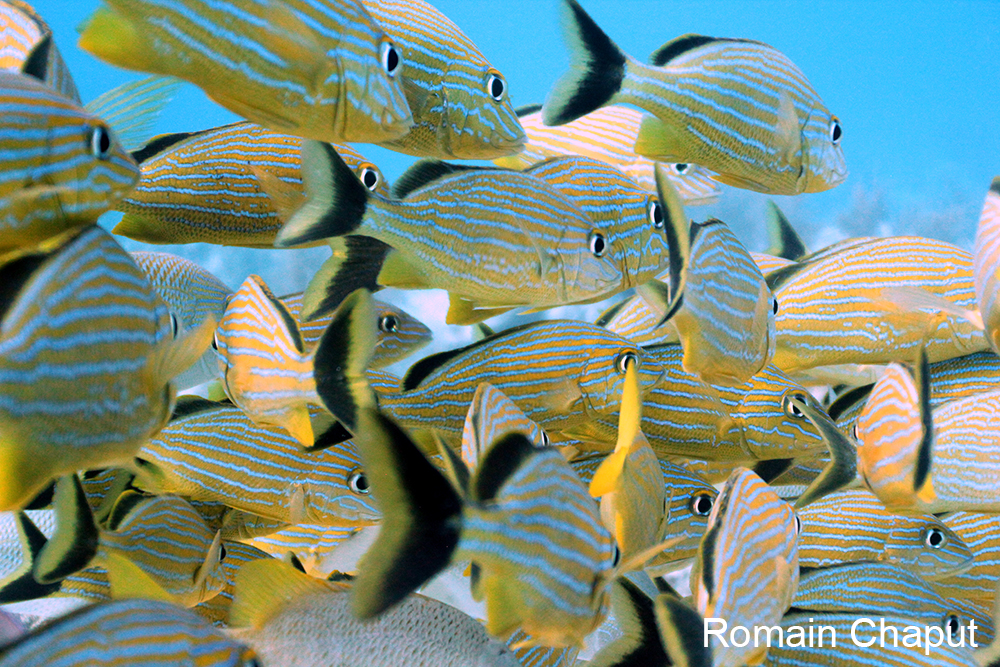
Blue Striped Grunt
(Haemulon sciurus)
While out scuba diving or snorkeling, you may see shoals of grunt along reef ledges, such as these blue striped grunt (Haemulon sciurus). Adults spend their time in coastal and offshore waters, while juveniles are more common around inshore habitats such mangrove forests.
Photo: Romain Chaput/Get Into Your Sanctuary Photo Contest

Midnight Parrotfish
(Scarus coelestinus)
Midnight parrotfish may be pretty, but they're so much more than their good looks! In Florida Keys National Marine Sanctuary, they and other types of parrotfish feed on algae, which helps protect corals by keeping algae growth in check on the reef. Under FWC regulations, parrotfish are not to be harvested for food.
Photo: Bill Goodwin/NOAA

French Angelfish
(Pomacanthus paru)
Angelfishes such as this French angelfish (Pomacanthus paru) are among some of the most colorful and recognizable reef fish in Florida Keys National Marine Sanctuary. These fish primarily feed on sponges, as well as corals, tunicates, and algae.
Photo: Daryl Duda/Get Into Your Sanctuary Photo Contest

Green Moray Eel
(Gymnothorax funebris)
Moray eels have thin teeth that protrude from the upper and lower jaws, and sometimes from the roof of the mouth. The teeth point backwards to prevent slippery prey from escaping. These eels are actually brown in color, but appear green due to a layer of yellow mucus that protects them from parasites. In addition to the green moray eel (Gymnothorax funebris), you can also find other eel species hiding in reef crevices in Florida Keys National Marine Sanctuary, such as the spotted moray (Gymnothorax moringa) and the sharptail eel (Myrichthys breviceps).
Photo: Rachel Plunkett

Red Lionfish
(Pterois volitans)
The population explosion of the invasive Indo-Pacific lionfish (Pterois volitans and Pterois miles) in the Atlantic, Gulf of America, and Caribbean is a serious threat to coral reefs. Although native to the Indo-Pacific region, lionfish were introduced to the Western Hemisphere by accident. Learn how NOAA and its partners are working to keep lionfish populations in check.
Photo: NOAA

Caribbean Reef Shark
(Carcharhinus perezi)
The Caribbean reef shark is one of the largest apex predators in the reef ecosystem, feeding on a variety of fishes. A heavy-bodied shark with a "typical" streamlined shape, it is difficult to distinguish the reef shark from other large requiem shark species.
Photo: Ben Edmonds/NOAA

Nurse Shark
(Ginglymostoma cirratum)
Nurse sharks are a type of demersal shark and spend most of their time resting on the seafloor. Their mouths are located on the underside of their bodies, allowing them to sift through sand and substrate for foods such as crab, shrimp, and octopus. Nurse sharks are yellow to grayish-brown in color and have rounded first and second dorsal fins.
Photo: Daryl Duda/Get Into Your Sanctuary Photo Contest
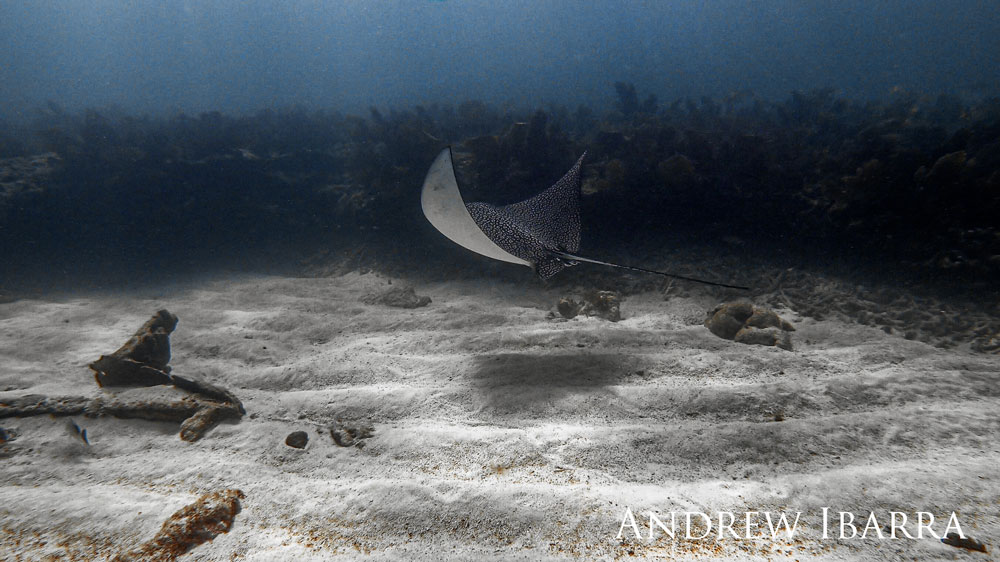
Spotted Eagle Ray
(Aetobatus narinari)
The spotted eagle ray (Aetobatus narinari), like other true stingrays, is a cartilaginous fish related to sharks. This species is protected in Florida State Waters. This ray species sometimes forms large schools and may be sighted swimming near the water surface, occasionally leaping completely out of the water. To defend against predators, such as hammerhead sharks, they have a sharp barb located at the base of their tail.
Photo: Andrew Ibarra/Get Into Your Sanctuary Photo Contest
Marine Mammals

Bottlenose Dolphin
(Tursiops truncatus)
Bottlenose dolphins, playful and smart, can reach speeds up to 18 miles per hour. Adults can transmit cultural knowledge from generation to generation, and their considerable intelligence has driven fascination by humans. All dolphins and porpoises are protected under the Marine Mammal Protection Act.
Photo: NOAA

Florida Manatee
(Trichechus manatus latirostris)
The Florida manatee is a subspecies of the West Indian manatee (Trichechus manatus) that prefers warm, shallow waters. Many will migrate long distances to their wintering grounds in Florida, while others are year-long residents. Because manatees tend to hang near the shoreline, munching pounds of seagrass and surfacing to breathe air, boat strikes have long been a threat to their population. This federally-protected species needs your help. Keep an eye out for manatees while boating and follow posted speed limits. Report injured, orphaned, entangled, distressed, or dead manatees to FWC.
Photo: Sam Farkas/NOAA
Reptiles
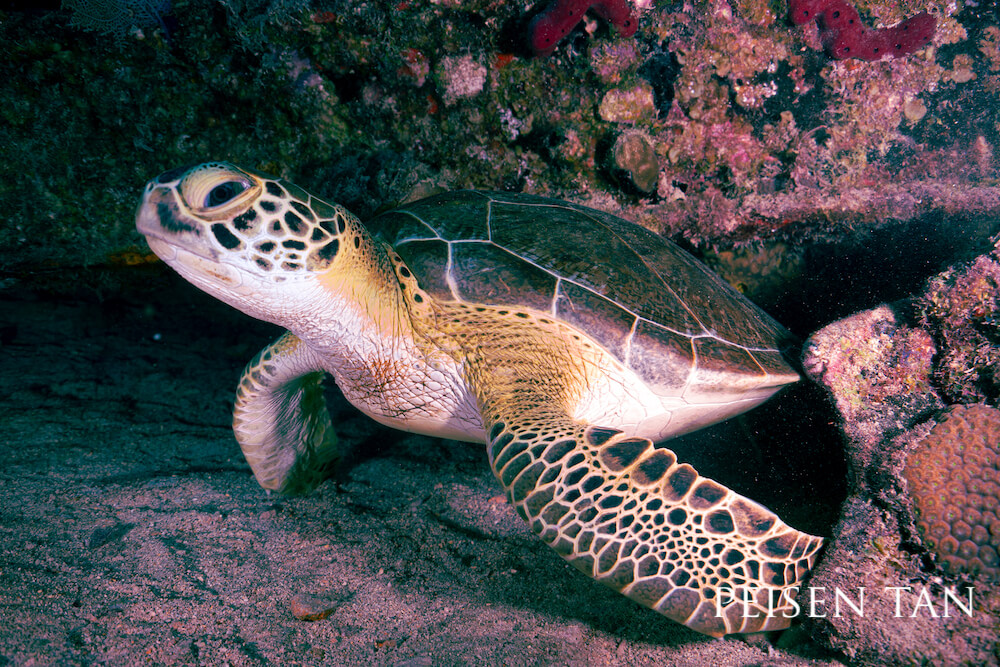
Green Sea Turtle
(Chelonia mydas)
This species of marine sea turtle's diet consists mostly of plants and algae, though they can occasionally be seen munching on a moon jelly. Their carapace (upper shell) is olive brown with dark streaks, and their plastron (bottom shell) is slightly yellow. The green sea turtle (Chelonia mydas) is protected as an Endangered species by the Federal Endangered Species Act and as a Federally-designated Endangered species by Florida's Endangered and Threatened Species Rule, and by Florida's Marine Turtle Protection Act.
Photo: Peisen Tan/Get Into Your Sanctuary Photo Contest

Hawksbill Sea Turtle
(Eretmochelys imbricata)
The hawksbill sea turtle (Eretmochelys imbricata) can be spotted on the reef foraging on algae, sponges, and mollusks. This marine turtle turtle species is most recognizable by its beak-like mouth and its shield-shaped carapace (upper shell) with blotchy brown, yellow, and black streaks. The hawksbill sea turtle is protected as an Endangered species by the Federal Endangered Species Act, as a Federally-designated Endangered species by Florida's Endangered and Threatened Species Rule, and by Florida's Marine Turtle Protection Act.
Photo: NOAA
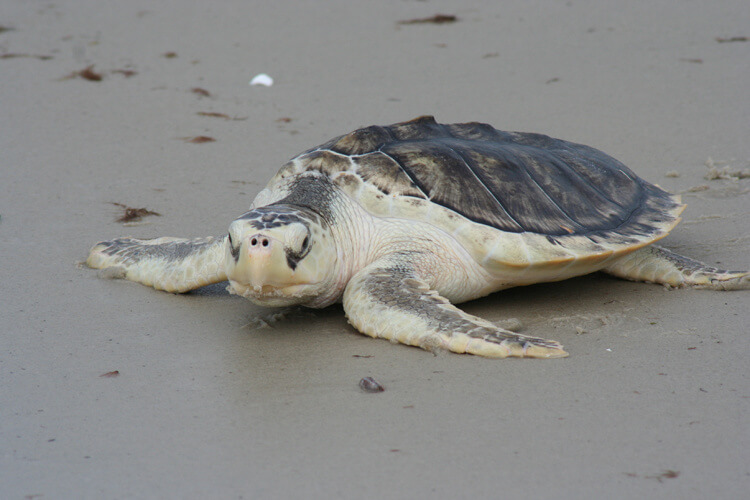
Kemp's Ridley Sea Turtle
(Lepidochelys kempii)
The Kemp's Ridley sea turtle (Lepidochelys kempii) is the smallest of all sea turtles. Key West's Richard Moore Kemp (1825–1908) was the first to identify the namesake species. It is also the rarest and most endangered turtle in the world, and its only major nesting beach is an area called Rancho Nuevo on the Gulf of America. The Kemp's Ridley sea turtle is protected as an Endangered species by the Federal Endangered Species Act and as a Federally-designated Endangered species by Florida's Endangered and Threatened Species Rule, and by Florida's Marine Turtle Protection Act.
Photo: Kate Sampson, NOAA Fisheries
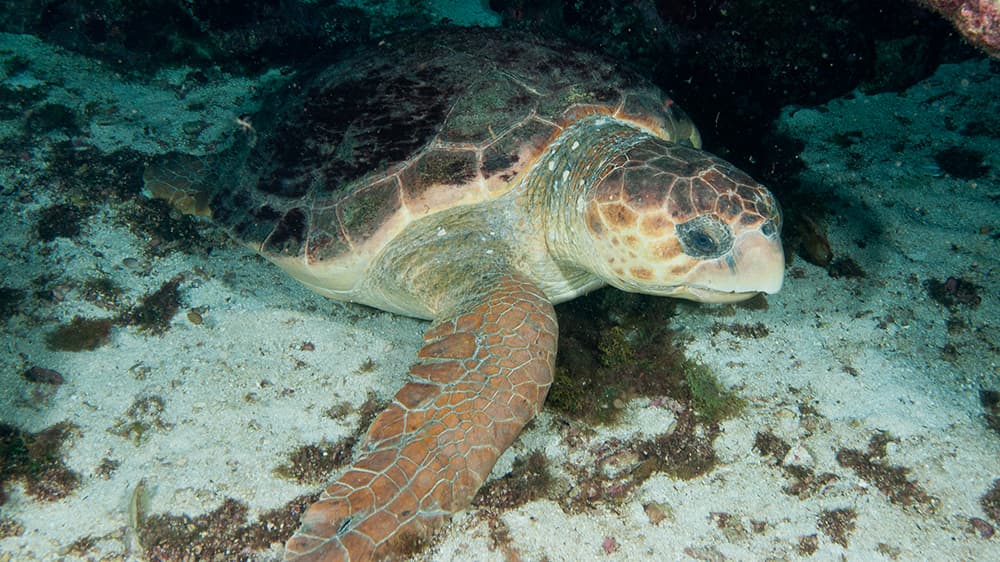
Loggerhead Sea Turtle
(Caretta caretta)
The loggerhead sea turtle (Caretta caretta) is the world's largest hard-shelled turtle, and nests over the broadest geographical range of any other. Powerful jaws enable them to feed on hard-shelled prey, such as whelks and conchs. Adults can reach up to 250 pounds. The loggerhead sea turtle is protected as a Threatened species by the Federal Endangered Species Act and as a Federally-designated Threatened species by Florida's Endangered and Threatened Species Rule, and by Florida's Marine Turtle Protection Act.
Photo: GP Schmahl/NOAA

Leatherback Sea Turtle
(Dermochelys coriacea)
Leatherback sea turtle (Dermochelys coriacea) is the largest living reptile in the world. Mature males and females can be as long as 6.5 feet and weigh almost 2,000 pounds. The leatherback is black with white, pink, and blue splotches, and its shell is made of a thick layer of fatty tissue overlayed with a mosaic of tiny bones, and a thin layer of skin. It is the only sea turtle that lacks a hard, bony shell. The leatherback sea turtle is protected as an Endangered species by the Federal Endangered Species Act and as a Federally-designated Endangered species by Florida's Endangered and Threatened Species Rule, and by Florida's Marine Turtle Protection Act.
Photo: NOAA Fisheries

American Crocodile
(Crocodylus acutus)
The American crocodile (Crocodylus acutus) belongs to a group of reptiles called crocodilians, which are the largest living reptiles. Although they are often mistaken for their close relative, the alligator, the American crocodile is distinguishable by the grayish green coloration of its rough, scaly skin, and its narrow, tapered, triangular snout. American crocodiles have a lizard-shaped body, with a long muscular tail and four short legs. Male crocodiles can reach up to 20 feet in length, while females are generally smaller at around 8–12 feet. A large adult crocodile can grow to over 2,000 pounds!
Photo: Avery Bristol/FWC
Birds

Great White Heron
(Ardea herodias)
The great white heron is a wading bird that can only be found in South Florida and the Florida Keys. It is the largest heron species. These birds forage in turtle grass beds where the tidal cycle limits their access to food. Whether the great white heron is a color morph or a subspecies of the great blue heron, or its own distinct species, is a topic that is still being researched.
Photo: Kristie Killam/USFWS
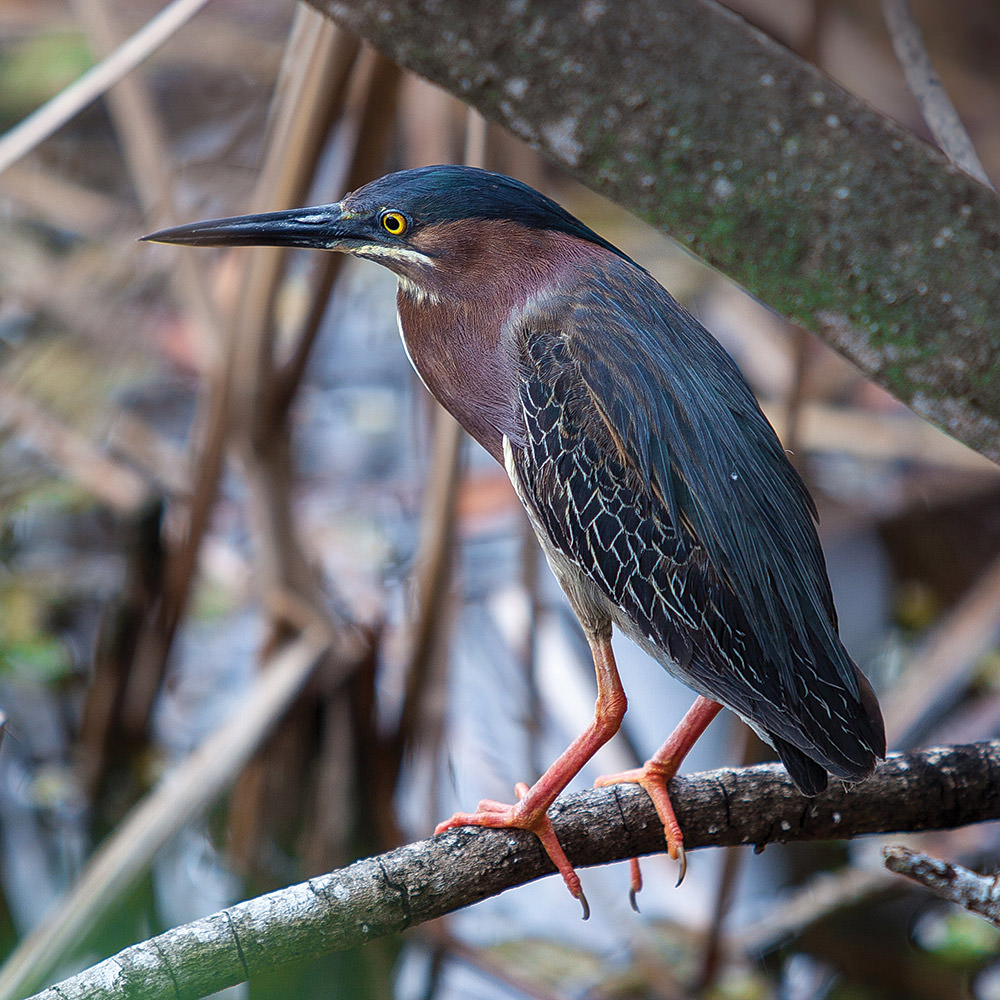
Green Heron
(Butorides virescens)
The green heron (Butorides virescens) is one of many gorgeous bird species that can be found in Florida Keys National Marine Sanctuary. These clever birds can use "bait" like a twig or an insect to lure in fish prey.
Photo: Matt McIntosh/NOAA

Roseate Spoonbill
(Platalea ajaja)
A gregarious wading bird, its brilliant pink color is derived from its diet. The crustaceans and other aquatic invertebrates it eats contain pigments called carotenoids that turn the birds' feathers pink. Plume hunting in the 18th and 19th centuries almost drove the roseate spoonbill to extinction, which was one of the motivations to create the Key West National Wildlife Refuge.
Photo: Ding Darling/USFWS
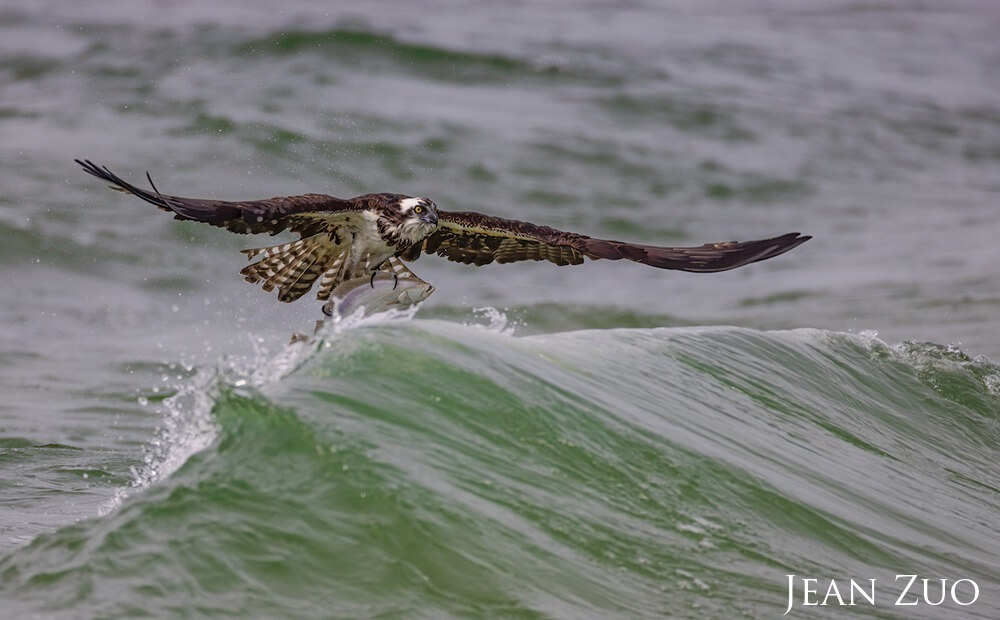
Osprey
(Pandion haliaetus)
Osprey (Pandion haliaetus), also known as the "fish hawk," has that is 99% fish. It is a large raptor, reaching more than 24 inches in length and has a 71-inch wingspan.
Photo: Jean Zuo/Get Into Your Sanctuary Photo Contest
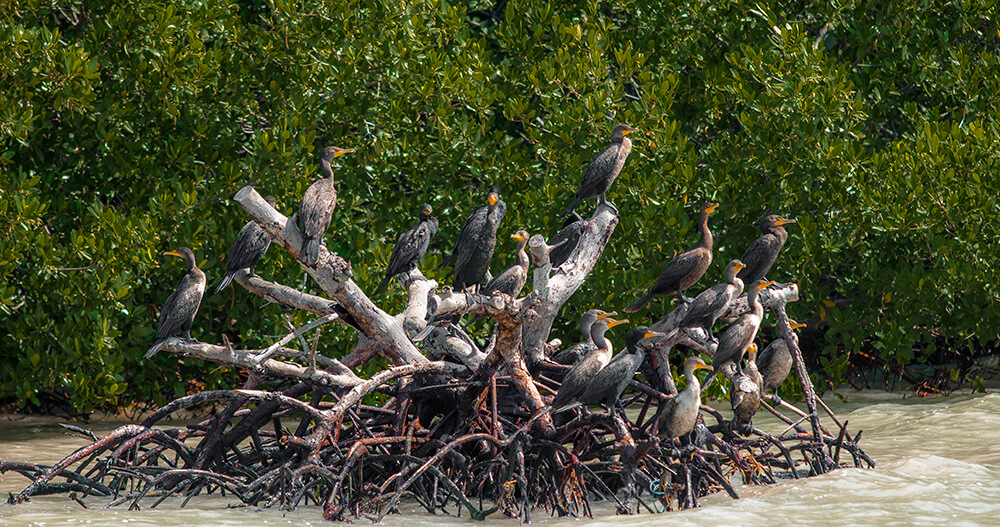
Double-Crested Cormorant
(Nannopterum auritum)
There are roughly 40 species of aquatic birds commonly known as cormorants, which nest in colonies. The most commonly seen cormorant in Florida is the double-crested cormorant (Nannopterum auritum). Cormorants are expert divers that can reach depths up to 150 feet. After fishing, cormorants are frequently seen holding their wings out in the sun to dry. This behavior is due to the fact that their feathers have less natural waterproofing than other diving birds, and can get waterlogged.
Photo: David J. Ruck/NOAA

White Ibis
(Eudocimus albus)
During the breeding season, the American white ibis (Eudocimus albus) gathers in large colonies near water. Pairs are predominantly monogamous and both parents care for the young. Native American folklore held that the bird was the last to seek shelter before a hurricane, and the first to emerge afterwards. The bird was thus a symbol for danger and optimism.
Photo: Matt McIntosh/NOAA

Brown Pelican
(Pelecanus occidentalis)
Pelicans have a distinctive pouch hanging from the bottom of their long bills. The brown pelican (Pelecanus occidentalis) is a large grayish-brown bird, and during breeding season, the plumage (feathers) turns bright yellow on the head and white on the neck. Juvenile pelicans are brown with a white belly (see picture). This seabird spends most of its time near the ocean, diving head-first into the water to scoop up fish near the surface.
Photo: David Ruck/NOAA

White Crowned Pigeon
(Patagioenas leucocephala)
This fruit and seed-eating bird can be found throughout parts of Florida and the Caribbean on mangrove keys and wooded islands, and primarily forms nesting colonies on small offshore islands. Its distribution in the United States is restricted to Florida Bay, Biscayne Bay, and the Florida Keys. It is named for the striking white cap of feathers atop its head. The white-crowned pigeon is protected by the U.S. Migratory Bird Treaty Act and as a state-designated threatened species by Florida’s Endangered and Threatened Species Rule.
Plants and Algae

Seagrasses
Seagrasses such as turtle grass (Thalassia testudinum) and manatee grass (Syringodium filiforme) form meadows in shallow, sandy, or even muddy locations throughout Florida, the Caribbean, and the Gulf of America. Rather than having roots, seagrasses grow from a long, jointed, rhizome. Many epiphytes (plant-like organisms that grow on the surface of another plant) grow on the seagrass blades, and the grasses are eaten by a variety of wildlife such as sea turtles, herbivorous parrotfish, surgeonfish, and sea urchins.
Photo: Rachel Plunkett

Red Mangrove
(Rhizophora mangle)
The trees you see in the water along the shores of the Florida Keys are mangroves. Mangroves are a salt-tolerant type of tree that line more than 1,800 miles of shoreline within Florida Keys National Marine Sanctuary. The prop roots of red mangroves (Rhizophora mangle) provide excellent structure for sponges, tunicates, algae, and barnacles, as well as habitat and hiding places for fish and invertebrates. The red mangrove is one of the three types of true mangroves that are common throughout the Florida Keys.
Photo: Olivia Williamson/Get Into Your Sanctuary Photo Contest

Phytoplankton
Phytoplankton, also known as microalgae, are similar to land-based plants in that they contain chlorophyll and require sunlight in order to live and grow. Most phytoplankton are buoyant and float in the upper part of the ocean, where they provide food for a wide range of sea creatures including krill, shrimp, snails, and jellies, that are in turn food for larger animals like sea turtles, fish, and whales.
Photo: NOAA Marine Ecosystem Analysis project

Caulerpa Algae
(Caulerpa spp.)
Caulerpa is a genus of green macroalgae that grows attached to nearshore and bay bottoms and other substrates. This is a genus of fast-growing green algae with leaf-like blades that come in a variety of shapes. Some species of Caulerpa are native to Florida, while others were accidentally introduced.
Photo: Rachel Plunkett

Halimeda Algae
(Halimeda spp.)
Halimedia algae are a type of green, calcareous algae that are important makers of carbonate sediments in Florida Keys National Marine Sanctuary. This algae grows in segments, and when it dies, it leaves behind calcified fragments that break down into sand. There are a few different species present in the Florida Keys, including the watercress algae (Halimedia opuntia, photographed above), which forms thick clumps in grooves, depressions, and cracks on the reef.
Photo: Rachel Plunkett

Sargassum Algae
(Sargassum spp.)
Sargassum are a brown macroalgae that grow in the Sargasso Sea and are transported to Florida via currents. The two species of sargassum found here are Sargassum natans and Sargassum fluitans. While floating at sea, Sargassum provides habitat for endangered juvenile sea turtles and hiding places for small crabs and other invertebrates. The algae also washes up on shorelines, providing an excellent food source for birds. Unfortunately, large blooms of drift algae can harm coastal ecosystems by shading seagrass meadows, which need sunlight to grow.
Photo: Rachel Plunkett

